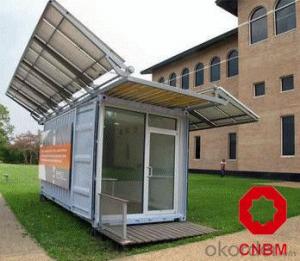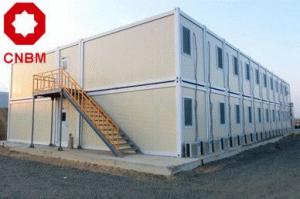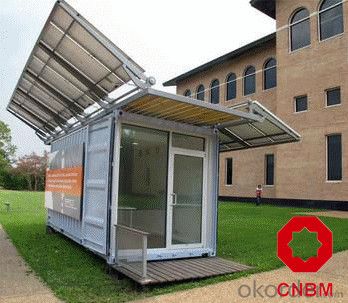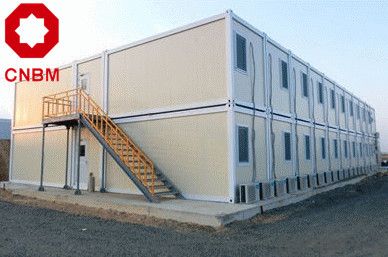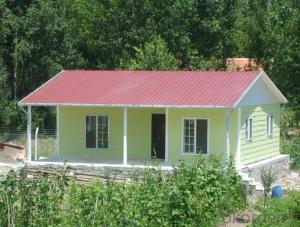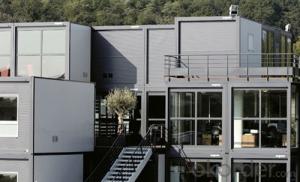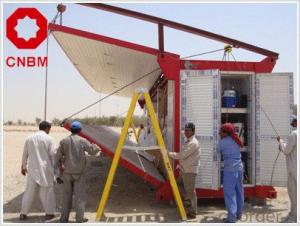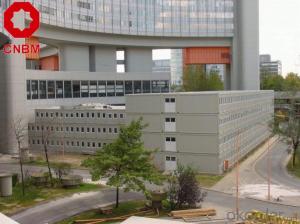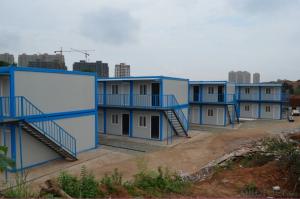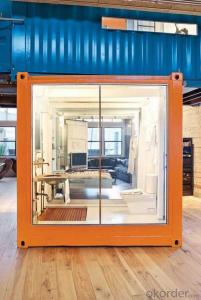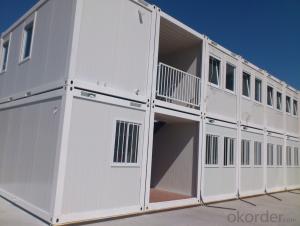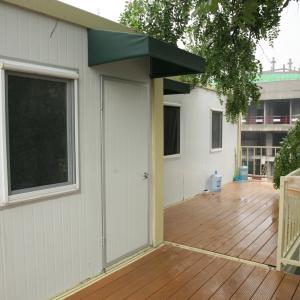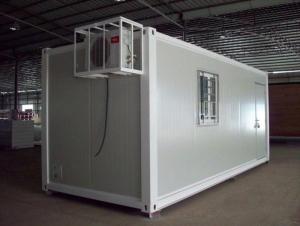Mobile Container House or Home Made in China
- Loading Port:
- Tianjin
- Payment Terms:
- TT OR LC
- Min Order Qty:
- 1 set
- Supply Capability:
- 1000 set/month
OKorder Service Pledge
OKorder Financial Service
You Might Also Like
Mobile Container House Made in China
Characteristic :
(1) With good appearance and can designed with customers' requirement.;
(2) Have strong earthquake resistance, high wind resistance , sound-insulated and anti-distortion ability;
(3) With good thermal insulation, and waterproof ability;
(4) Repetitive to use;
(5) Transportation convenient;
(6) Service life is long, can reach up to 15-20 years.
| The detailed information as follows: | |||
| Sort | Name | Specification | |
| Specification | 20’GP | Length:6055mm Width:2438m Height:2591mm Weight:2145KGS | |
| 40’GP | Length:12192mm Width:2438mm Height:2591mm Weight:3650KGS | ||
| 40’HQ | Length:12192mm Width2438mm Height:2896mm Weight:3800KGS | ||
| Standard accessory | Wall | Material: steel | |
| Roof | Material: steel | ||
| Door | Aluminium alloy, wood ,steel or customers' requirement | ||
| Window | Aluminium alloy, wood or customers’ requirement | ||
| Decorative floor | PVC or laminated flooring in living area and aluminium panel in bathroom and kitchen or customers’ requirement | ||
| Water supply and Drainage system | Provided plan, design and construction or customers’ requirement | ||
| Electric system | Provided plan, design and construction or customers’ requirement | ||
| Technical parameter | Resistant temperature | -50°C to 70°C | |
| Fire proof | B2 grade | ||
| Earthquake resistance | 8Grade | ||
| Wind resistant | 120km/h | ||

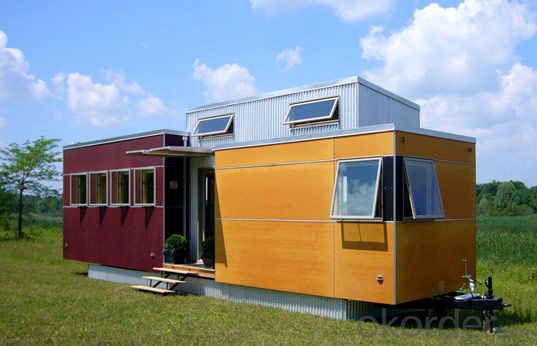
Main material a. light steel as steel structure, including C section steel, V section steel, square steel tube
b. Various sandwich panels for wall and roof, the insulation can be EPS, rock wool, fiber glass wool
Window Aluminum alloy window with roller shutter, plastic-steel window
Door EPS/rock wool/fiber glass wool sandwich panel door, steel/plastic-steel/aluminum alloy door
Optional items We can supply you bathroom, kitchen, electricity system, home appliance, furniture and other components as per your request
Information For Customers:
If the customer can provide the following information it will be very helpful:
1.The dimension of the house:20',40 or 40'HQ container size
2.The quantity you need
3.The function of the house, or if need interior equipment
4.The class of the house: the high, the middle or the low class
The container house are constructed from ISO standard shipping containers,which is ideal choice for people who wants to make full use of indoor space, environment friendly,recycled.
- Q: What types of container houses are available?
- There are several types of container houses available today, each offering unique features and advantages. Here are some of the most common types: 1. Single-Container Homes: These are made by converting a single shipping container into a livable space. They are compact and can be easily transported and set up on any location. Single-container homes are a popular choice for individuals or small families looking for an affordable and sustainable housing option. 2. Multi-Container Homes: These homes are created by combining two or more shipping containers to create a larger living space. Multi-container houses can be designed in various configurations, allowing for more flexibility and customization. They are suitable for larger families or people looking for more spacious living quarters. 3. Container Tiny Homes: As the name suggests, these are small-sized container houses designed to maximize efficiency and minimize space usage. These compact homes are perfect for individuals or couples looking for a minimalist and affordable living solution. They can be easily transported and placed in various locations. 4. Off-Grid Container Homes: These container houses are designed to be self-sufficient and independent from traditional utility connections. They are equipped with solar panels, rainwater harvesting systems, composting toilets, and other sustainable features. Off-grid container homes are ideal for those seeking to minimize their environmental impact and live off the grid. 5. Luxury Container Homes: These container houses are designed with high-end finishes and luxurious features. They often feature larger floor plans, upscale materials, and modern amenities such as gourmet kitchens, spa-like bathrooms, and high-tech entertainment systems. Luxury container homes offer a stylish and upscale living experience. 6. Hybrid Container Homes: These houses combine shipping containers with traditional construction methods to create a unique and customized living space. The hybrid design allows for more design flexibility and can incorporate various architectural styles. These container houses offer a blend of durability and aesthetics. It's worth noting that container houses can be further customized and modified based on individual preferences and needs. Whether you are looking for a small and affordable home or a spacious and luxurious dwelling, there is a container house type available to suit your requirements.
- Q: Are container houses safe to live in?
- When container houses are designed, constructed, and maintained properly, they are indeed safe to live in. These houses are made from steel shipping containers, which are highly durable and designed to withstand even the harshest transportation conditions. They have been extensively tested and proven to be structurally sound, capable of withstanding hurricanes, earthquakes, and heavy snow loads. To ensure the safety of residents, container houses undergo various modifications to meet building and safety regulations. These modifications involve reinforcing the structure with additional steel beams, installing proper insulation and ventilation systems, and incorporating windows and doors that meet safety standards. Furthermore, container houses can be equipped with all the necessary amenities to provide a comfortable and secure living environment. They can be designed to include plumbing and electrical systems, heating and cooling units, and even fire suppression systems. Proper insulation can also be added to maintain comfortable indoor temperatures and improve energy efficiency. It is crucial to note that, similar to any other form of housing, the safety of a container house largely depends on the quality of construction and adherence to building codes. Therefore, it is essential to collaborate with reputable and experienced professionals during the design and construction process to ensure that all safety requirements are met. In conclusion, when designed and constructed properly, container houses can serve as safe and practical housing options. They offer durability, resistance to extreme weather conditions, and the ability to provide all necessary amenities for a comfortable and secure living environment.
- Q: Are container houses suitable for remote or secluded living?
- Yes, container houses are suitable for remote or secluded living. Due to their modular and portable nature, container houses can be easily transported to remote locations, making them an ideal choice for people who want to live in secluded areas. These houses are designed to be self-sufficient and can provide all the necessary amenities required for comfortable living. They can be equipped with solar panels for electricity, rainwater harvesting systems for water supply, and efficient insulation for maintaining a comfortable temperature. Additionally, container houses are durable and can withstand harsh weather conditions, making them a reliable option for remote living. Their compact size also allows for easy maintenance and reduces the environmental impact. Overall, container houses offer a practical and sustainable housing solution for individuals seeking a remote or secluded lifestyle.
- Q: Are container houses resistant to mold or mildew?
- Container houses can be resistant to mold or mildew if proper precautions and maintenance are followed. The key factor in preventing mold or mildew growth is moisture control. Since containers are made of metal, they are naturally resistant to moisture penetration. However, if there are any leaks or gaps in the container, moisture can seep in and create a conducive environment for mold or mildew to grow. To ensure resistance to mold or mildew, it is recommended to properly seal and insulate the container to prevent any moisture from entering. This includes sealing any gaps or holes, properly insulating the walls, and installing a vapor barrier to control humidity levels. Additionally, proper ventilation is crucial to prevent the buildup of moisture inside the container. Regular maintenance is also essential to prevent mold or mildew growth. This includes routinely checking for any leaks or damages, promptly repairing them, and ensuring proper airflow and ventilation within the container. Regular cleaning and disinfection of the interior surfaces can also help prevent the growth of mold or mildew. It is important to note that while container houses can be resistant to mold or mildew, it ultimately depends on the materials used, construction techniques, and maintenance practices. Consulting with professionals and following proper guidelines can help ensure that container houses remain resistant to mold or mildew.
- Q: How do container houses compare to traditional houses in terms of insulation?
- Container houses typically have poorer insulation compared to traditional houses. This is mainly due to the materials used in their construction, such as steel walls that conduct heat and cold more easily than traditional building materials like wood or brick. However, with proper insulation upgrades, container houses can achieve similar levels of insulation as traditional houses.
- Q: Can container houses be designed with earthquake-resistant features?
- Yes, container houses can be designed with earthquake-resistant features. By incorporating reinforced foundations, flexible connections, and bracing systems, container houses can withstand seismic activity. Additionally, using lightweight materials and distributing weight evenly within the structure can help minimize the impact of ground shaking.
- Q: Are container houses noisy?
- The level of noise in container houses can vary depending on several factors. One crucial factor is the type of insulation used in the container. By ensuring proper insulation, noise levels can be significantly reduced, resulting in a quieter environment inside the house. Another aspect to consider is the location of the container house. If it happens to be situated in a bustling area, like close to a highway or airport, it is more likely to be noisier compared to a container house in a peaceful neighborhood. Nevertheless, implementing effective soundproofing techniques such as double-glazed windows and insulated walls can make container houses more comfortable and less noisy to live in.
- Q: Can container houses be easily transported to different locations?
- Yes, container houses are designed to be easily transported to different locations. One of the main advantages of container houses is their mobility. These houses are built using shipping containers, which are specifically designed for transportation purposes. They can be easily loaded onto trucks, ships, or trains for transportation to different locations. Additionally, container houses are lightweight and compact, making them convenient for long-distance travel. They can be easily dismantled and reassembled at a new location, allowing for quick and efficient relocation. Overall, container houses offer a flexible and convenient housing solution that can be easily transported to different locations.
- Q: Are container houses suitable for extreme climates?
- Container houses can be suitable for extreme climates, but it largely depends on the design and insulation of the structure. With proper planning and modifications, container houses can withstand harsh weather conditions and provide a comfortable living environment. One of the main challenges of extreme climates is temperature control. Container houses can be insulated effectively, preventing excessive heat loss or gain. This can be achieved by using high-quality insulation materials and adding additional layers to the walls, floors, and roofs. Insulation also helps in reducing energy consumption for heating or cooling, making container houses more sustainable. In regions with extremely cold climates, the design of the container house can be optimized to maximize heat retention. This can include installing double-glazed windows, using insulated doors, and incorporating passive solar techniques like orienting the house to capture sunlight. Additionally, the use of heating systems such as radiant floor heating or wood stoves can further enhance the thermal comfort inside the container house. For areas with scorching heat or high humidity, container houses can be adapted to provide better ventilation and airflow. This can be achieved by incorporating windows, skylights, or even adding a rooftop garden or green roof to reduce heat absorption. Cross-ventilation can also be achieved by strategically placing windows or using fans to circulate air effectively. Furthermore, container houses can be designed to withstand extreme weather events, such as hurricanes or earthquakes. Reinforcements can be added to the structure, including steel frames or additional support columns, to increase its stability and resilience. However, it is important to note that container houses may require additional maintenance and regular inspections in extreme climates. This is to ensure that the insulation remains intact, there are no leaks, and the structure is in good condition to withstand any weather conditions. In conclusion, container houses can be suitable for extreme climates with proper design, insulation, and modifications. While they may require extra considerations and maintenance, container houses offer an affordable and sustainable housing solution that can withstand the challenges of extreme weather conditions.
- Q: Are container houses suitable for areas with extreme weather conditions?
- How container houses perform in areas with extreme weather conditions depends on their design and construction. If properly designed and constructed, container houses can withstand extreme heat, cold, wind, and even seismic activity. One of the main advantages of container houses is their structural strength. Shipping containers are built to endure harsh conditions during transportation, including storms and rough seas. This inherent strength makes them a suitable choice for areas prone to hurricanes, tornadoes, or heavy snow loads. By adding extra steel supports, the container's ability to withstand extreme weather conditions can be further enhanced. Insulation is another crucial factor in making container houses suitable for extreme weather. Proper insulation helps regulate the internal temperature, keeping the interior cool in hot climates and warm in cold climates. Various insulation materials, such as spray foam, rigid foam boards, or fiberglass batts, can be used to achieve this. Additionally, double-glazed windows and energy-efficient doors can contribute to better insulation and energy savings. Moreover, container houses can be designed with features that reduce the impact of extreme weather. For instance, sloped roofs can effectively shed snow or rainwater, preventing excessive weight or leakage. Installing hurricane shutters or impact-resistant windows can protect against high winds and flying debris. Additionally, incorporating passive design principles, like strategically placed windows for natural light and ventilation, can reduce the reliance on mechanical heating or cooling systems. However, it is important to note that container houses still require careful planning, engineering, and professional construction to ensure their suitability for extreme weather conditions. Local building codes and regulations should be followed, and consulting experts in container house construction is highly recommended. With the right design, materials, and construction techniques, container houses can indeed be a viable option for areas with extreme weather conditions.
Send your message to us
Mobile Container House or Home Made in China
- Loading Port:
- Tianjin
- Payment Terms:
- TT OR LC
- Min Order Qty:
- 1 set
- Supply Capability:
- 1000 set/month
OKorder Service Pledge
OKorder Financial Service
Similar products
Hot products
Hot Searches
Related keywords
